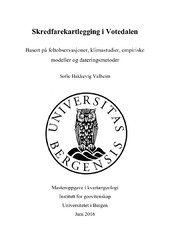| dc.description.abstract | Avalanche hazard mapping is an important mitigation measure for hazardous areas. It helps to better understand what areas that need to be secured and what safety measures that should be considered. The combination of such mapping and Building Acts and Regulation (TEK10) determine the areas that are safe for new building developments. The aim of this project was to map the avalanche hazard in Votedalen, including hazards like snow avalanches, rock falls and landslides. The work involved analysis of climate records, future climate prognoses and past avalanches in the fieldwork area. It also included using dating methods, lichenometry and schmidthammer on the avalanche deposits to help understand the frequency of avalanches. Furthermore, the scope of the project implied calculation of the run-out distance by applying the alpha-beta method and use of the Height-Length ratio. In addition, a few simulations were done in Rocfall. Results from the alpha-beta method became the key source for calculating the run-out distance whilst, simulations in Rocfall and the results from calculating by Height- Length ratio were used to support such data. Information gained through fieldwork and conversations with locals was also very important when analysing the quality of the data. The results from the lichenometry and schmidthammer in assessing the age of the various rocks in the area did not correspond with observations from the fieldwork and the stories shared by the locals. However, though the lichenometry method did underestimate the age of the deposits, it can be used to determine the minimum age of the rocks. The results from the schmidthammer were also concluded to be inaccurate. There are several reasons why these methods failed to provide more correct data, the main ones being the extent of vegetation on the site and the challenging conditions of the rock surfaces. The results from these methods combined with field observations and local stories did however support the conclusion that there is a high frequency of avalanches in Votedalen. The frequency of avalanche in Bergheim was lower. The run-out distance was different depending on the method used. While the Height-Length ratio was overestimating the range, the Rocfall simulations were underestimating it. The alpha-beta method did however compare well with observations gained during fieldwork and local stories. There is no doubt that Votedalen is a high-risk area with a high frequency rate for avalanches. In 2016 it was finally decided to build a tunnel through the valley, and the results documented in this projects support this decision. | en_US |
